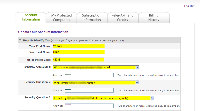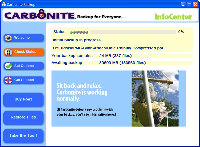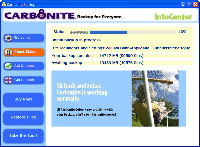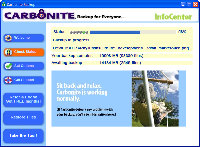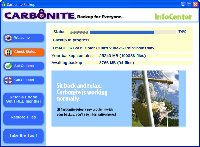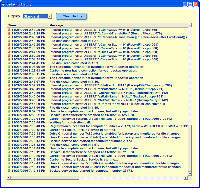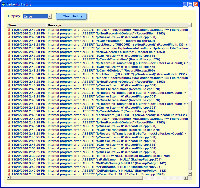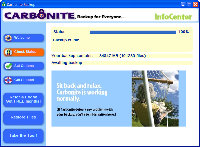 |
||||||||||||||||||||||||||||||||||||||||||||||||||||||||||||||||
| Previous page | Do you use a pop-up blocker? If so, please read this. | |||||||||||||||||||||||||||||||||||||||||||||||||||||||||||||||
|
Date: 2006.12.17 |
||||||||||||||||||||||||||||||||||||||||||||||||||||||||||||||||
|
||||||||||||||||||||||||||||||||||||||||||||||||||||||||||||||||
I keep forgetting about memoryWhen I bought my first IBM-compatible computer (a Zenith) it came with 256KB of RAM. Being the big spender that I am (yeah, right!) and wanting maximum performance from the 4.77MHz processor (Yeah! Right!), I spent $100 or more extra to upgrade the memory to an astonishing 320KB of RAM. Recently I bought a couple of 1GB Compact Flash cards for my digital camera. They cost less than $40. Last week, I bought a 2GB USB flash drive at Office Max. The list price was $70, but it was on sale for $38 and I had a coupon good for $10 off any purchase of $20 or more, so the 2GB drive cost $28 plus tax. The entire purchase was less than $30. The first USB flash drive I had was from a company in Israel. 16MB for about $50 – about $3.13 per megabyte. At $30 for 2GB, the price per megabyte is $0.015 – one and one half cents. That's about 6 tenths of a percent of the cost of the original. So much memory can be placed in so small a package. This 2GB flash drive is about the same width as the original, but it's only half as long and about half as thick. It could be narrower, too, if not for the USB connector. The same thing is true of hard drives. It's not at all difficult to find a 200GB hard drive from a good manufacturer (Seagate, for example). Tiger Direct this week has both a 320GB SATA drive and 2 250GB Seagate drives (one ATA and one SATA) for $80. NewEgg has similar deals. Micro Center shows a 160GB Seagate SATA drive for $60. This is wonderful news for somebody like me. I have 100GB or so of digital audio files and a like amount of space (or more) full of digital camera images. Wonderful. And scary. Disks do still failThe reliability is phenomenal these days. Mean time between failure (MTBF) exceed 1,000,000 hours! That's something like 114 years and patently absurd, but it's what some manufacturers are citing. Only a fool would depend on that, though. Or even a quarter of that. The numbers are theoretical. A hard drive can fail immediately or in an hour. Most will provide good service for 4 or 5 years. Some will continue to operate for a decade or more. Anything over 4 years is gravy, though. Two of the computers I owned continue to provide service for the people who purchased them from me when I upgraded. One of those computers is more than 10 years old and the disk hasn't failed. In part that's because I specified quality components when I built the computer, but a lot of it is sheer luck. With drives growing so large, having a full backup is harder than ever. I outgrew tapes several years ago and have depended on external hard drives, but there are disadvantages. The most significant problem is the fact that I run backups only once per week. On Monday, I bring the external drives home from the office, run the backup, and return them to the office on Tuesday. Although I copy critical working files to USB flash drives during the week, I still have significant exposure. And that leads me to ... Easy on-line backup at an attractive priceBackup is essential. If you don't backup your files, you'll regret it. Maybe not today. Maybe not tomorrow, but soon and for the rest of your life. (Apologies to Humphrey Bogart.) The trouble with backup is that you have to do it. You need to schedule the process. You need to provide the system with the proper media. You need to store the media safely far from the computer. So all too often backup doesn't get done. People mean to do it, but they don't. The ideal backup system would work invisibly and automatically. It would put your files in a safe place. And it wouldn't cost a lot. Easy, invisible, and automatic are aren't difficult to do. Inexpensive has been the sticking point. You'll find lots of on-line backup services that make the process easy, invisible, and automatic. But to backup 40GB of data, you'd pay Iomega more than $300 per month! Even the lower-priced services (iBackup and xDrive) are $600 per year. So what's the deal with this "Carbonite" service and the price of $5 no matter how many files you backup or how large the backup is? Can this be for real?
Oh ... and I have more like 100GB of data that I want to backup (and that doesn't include pictures from digital cameras and audio files). So that would be nearly $700 per month from Iomega? About $100 per month from iBackup and xDrive? And $10 per month from Carbonite? Sorry, but no. It would be $5 per month from Carbonite. The company says it offers "unlimited" backup for $5 per month. On its face, that's an absurd offer. I know disk space is cheap, but 100GB of storage still costs at least $50, so it would take Carbonite a year to recover just the cost of the hardware. I presume there are people who work for the company and hope to be paid. The company will also have to pay for Internet access.
How does it work?The process is easy enough, but it won't back up external drives of any sort or network drives. All of my audio files and photographs are on external USB devices. I can't back them up. The audio files are all on my overgrown Ipod (an old Ibook with a large external drive) at the office. All of the digital camera pictures are backed up to an external drive that lives at the office. If I decide to use Carbonite instead of my own backup drives, I'll have to find a way to get the digital images backed up. Carbonite doesn't work for Macs yet (it's coming next year), so daughter Kaydee can't back up her machine. Her backups already go to another external hard drive that's at the office, but we'll all be happy to automate the process in 2007.
One potential problemSeveral years ago, a worm has a payload designed to destroy files. The "I Love You" worm, which is still active, overwrites files with these extensions: vbs, vbe, js, jse, css, wsh, sct, hta, jpg, jpeg, wav, txt, gif, doc, htm, html, xls, ini, bat, com, avi, qt, mpg, mpeg, cpp, c, h, swd, psd, wri, mp3, and mp2. If your computer were to become infected with such a worm, an automatic backup service such as Carbonite would notice that the file had changed and would start backing them up. The files on your computer and the files in the backup would both be damaged. I view this as a threat, but it's one that's easily mitigated. The first thing any user should do if a worm seems to be present on your computer is shut down the network connection. The faster you act, the less damage there will be. Once you eradicate the worm, you can get back on the network and restore those files that were damaged on your machine but not yet picked up by Carbonite. Backup really is importantA co-worker recently discovered that her computer's Maxtor hard drive wouldn't boot. The computer failed during the weekend, so she was greeted on Monday morning by an on-screen message that said a file was corrupt. It was more than that. I booted the computer from the Windows CD and opened the Recovery Console. When I navigated to the root directory, I found a lot of important files that reported a length of 0 bytes. No matter how good a programmer is, it's difficult to cram anything useful into 0 bytes. Clearly, there was a problem. We replaced the hard drive and re-installed Windows, but she wanted the Outlook archive file that had been on the local drive instead of on the network drive. In other words, it hadn't been backed up. Fortunately, we found that the drive's main problem was the boot sector, so it could be mounted as a second drive. The Outlook pst file and other files that were on the hard drive were recoverable. Luck! Carbonite's test: Restoring filesA week after the full backup completed, I rarely see any activity from Carbonite. It shows 100% completion most of the time. When I add or change files, the marker that appears beside the file in the Windows Explorer turns yellow briefly and then turns green, indicating that it's been backed up. But what if I need one of those files? There's a new item in the Windows Explorer. "Carbonite Secure Backup" shows by directory and file every one of the 101,849 files that I've backed up. To restore one, all I have to do is navigate to it, right-click it, and choose "restore" to restore the file to its original location or "restore to" to restore the file to another location. I did that with a few files and some small directories. Because the download speed is nominally 4Mbps, files are restored almost instantly. Now I'm paying less than $5 per month for a secure backup. When Carbonite makes it possible to backup external USB drives next year, I'll pay another $5 per month to safeguard my drive M ("Multimedia"), which is where all my digital camera images are stored. And when they come up with an application that works with Apple's OS X, I'll kick in another $5 per month to back up Kaydee's computer. Carbonite's business model is an interesting one: Charge a price that's low enough to cover a bit more than your expenses for a service that everyone knows they need but don't want to spend a lot of money for. I wish them success. Not only because they have my data, but because the CEO seems genuinely to be interested in helping people avoid the pain of lost data. I spoke with David Friend, the Carbonite CEO, who started by describing a survey the company did recently of 500 PC users. Nearly 70% said that they had lost data in the last 2 years. The full interview is on the podcast (see link at the top of the page.) Carbonite requires a high-speed, always-on Internet connection. Overall: The easiest backup I've ever used.
|
||||||||||||||||||||||||||||||||||||||||||||||||||||||||||||||||
| Creating the information for each week's TechByter requires many hours of unpaid work. Please consider dropping a little money into the kitty to help. |
||||||||||||||||||||||||||||||||||||||||||||||||||||||||||||||||
|
||||||||||||||||||||||||||||||||||||||||||||||||||||||||||||||||
|
||||||||||||||||||||||||||||||||||||||||||||||||||||||||||||||||
| Home • Programs • Reference • Subscribe to Technology Corner News • Contact Us • Terms of Use ©2006 by William Blinn Communications. All rights reserved. This is the only ad you'll ever see on this site. It's for my website host, BlueHost in Orem, Utah. Over the past several years, they have proven to be honest, reliable, and progressive. If you need to host a website, please click the banner below to see what BlueHost has to offer. |
||||||||||||||||||||||||||||||||||||||||||||||||||||||||||||||||
Annoying legal disclaimerMy attorney says I really need to say this: The TechByter website is for informational purposes only. I assume no responsibility for its accuracy, although I do my best. The information is subject to change without notice. Any actions you take based on information from the radio program, the podcast, or from this website are entirely at your own risk. Products and services are mentioned for informational purposes only and their various trademarks and service marks are the property of their respective owners. TechByter cannot provide technical support for products or services mentioned. |
||||||||||||||||||||||||||||||||||||||||||||||||||||||||||||||||
